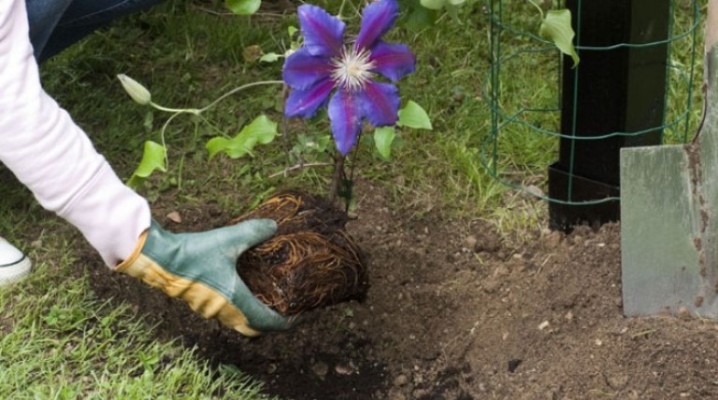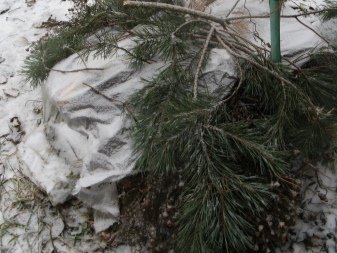How to transplant clematis correctly?

In summer cottages, in parks and squares, you can often see a beautiful blooming liana, whose large flowers are stunning in their colors. This is a clematis that will delight you with flowering from early spring to late summer. Many gardeners dream of clematis or have already purchased it, but they may not even guess that it needs to be transplanted regularly. Consider how to do it correctly and how to take care of the plant later.



Optimal timing
Clematis do not tolerate transplanting from one place to another, as they have a well-developed but delicate root system. It is better to immediately choose a permanent place of residence for them, but sometimes it is simply impossible to do without a transplant. There is no consensus on the optimal timing for replanting a plant. The timing depends on the region of growth and the climatic conditions of the season. But in most cases, it is not recommended to transplant clematis in the summer, they do this if there is no other way out. Summer begins the growing season and active sap flow, transplanting at this time can be detrimental to the plant.
In the early days adult clematis can be transplanted when the lighting has already become sufficient, and the soil has dried out from melted snow... In some regions, such conditions will be observed in late spring, while in others - in the summer, around June. Good lighting and breathable soil are the guarantee that the root system will develop correctly and well in a new place. And also it is worth paying attention to the buds of the plant. It is better that they do not have time to start growing before transplanting.
Important! Autumn is a priority time for transplanting clematis. The main thing is that at least a month remains before the first frost from the moment of transplantation, then clematis will have time to take root and will not die with proper shelter for the winter.

Seat selection
Clematis are transplanted if the soil is depleted in the old place or when the plant has become very large and requires dividing the bush. It is not easy for an adult liana to endure a change of scenery. One of the most important factors influencing the success of the transplant is the correct choice of the new location. Like most flowering lianas, clematis prefer bright spots. If they grow in shade, they may not even bloom. Open sunny areas are suitable, next to which trees with spreading crowns do not grow. Clematis is not a plant for a group.

Although clematis prefer abundant watering, they do not like stagnant moisture. They should not be planted in lowlands, as well as near buildings where water can accumulate. The groundwater level must also be quite low, otherwise the vine will die. Strong winds are the enemy of clematis. Its branches twine around the support, and the constant wind can prevent the vine from climbing up. Therefore, you should not plant clematis in drafts or on the leeward side. The soil in the new place of growth should be loamy, loose and fertilized.
To shade the root system, it is advisable to plant low-growing herbaceous plants in the root hole.

Step-by-step instruction
Insanely beautiful clematis must be transplanted very carefully so that it takes root well in a new place and does not die. For a beautifully flowering plant, transplanting will be a lot of stress. Our detailed step-by-step instructions will help to avoid many mistakes associated with transplanting clematis.
- Preparing the place. The site must first be cleaned of debris and branches.If the groundwater in a given place is rather high, but it is not possible to choose another, it is necessary to lay at least a primitive drainage system in the form of grooves.
- Digging a landing hole. Before planting clematis in open ground, you need to dig a planting hole that is suitable in size. The older the plant, the larger the diameter of this pit will be (minimum 0.7 m). After digging a hole, a drainage layer of expanded clay or broken brick is laid. Fertilizers are added to the excavated soil: compost or a universal remedy, as well as peat and sand. An earthen mound is poured from the prepared substrate into the center of the pit.
- We install the support. Clematis is a liana, so that he has something to lean on during growth, it is necessary to install special lattices. Having chosen the shape and size of the gratings, they must be firmly fixed at the base of the planting pit.
- Preparing the plant for transplantation. Before transplanting, the stems of clematis must be pruned, since, first of all, it needs strength for rooting, and not for the growth of shoots. The cut is performed quite strongly. Leave only 10 cm above the ground. After pruning, they begin to dig up the bush. It will not be possible to completely preserve a powerful root system, so they dig out an earthen lump as large as possible (about 50x50 cm). The rhizomes of an adult plant can be divided into several specimens and transplanted into different places. If clematis is sick, then its roots must be treated with fungicide solutions. Remember that hybrid varieties are particularly difficult to transplant and require more careful monitoring.
- We plant a plant. It is necessary to carefully spread the roots and put the plant in the ground on a prepared earthen mound, fixing it on a support. Then a mixture of earth and additional elements is poured on top and tamped a little. Young clematis deepen by the size of three lower buds, older ones at the age of two years or more - to a depth of about 20 cm.
- Watering clematis. After planting in a new place, the plant will require a lot of moisture. The trunk circle is watered abundantly with plenty of water. Do not use ice cold or too warm water. It is better if it is at the ambient temperature. A warm manganese solution can be used to disinfect the trunk circle.
- We loosen and mulch the soil. After watering, it is necessary to loosen the soil so that it does not crack, and then sprinkle it with a layer of mulch to avoid drying out. Such procedures will help the root system recover from a transplant faster.
Important! The transplanted clematis is restored for 1-2 years, after which it will please with abundant flowering.

Further care
Proper care of clematis after transplanting will help the plant to take root in a new place. Plants often die not only due to the wrong choice of place, but also without the correct further procedures. Clematis should be constantly in the field of view of the gardener in the first two years after transplantation. Consider what measures for the care of clematis must be.
- Watering. In hot weather, the newly transplanted clematis should be watered abundantly, since it cannot stand drought, and its leaves immediately wither. But stagnation of moisture is also destructive for him, so it is important to monitor this and, if necessary, dig drainage grooves. For plants up to two years old, 1-2 buckets of water are needed, for older specimens - 3-4 buckets. In the fall, watering is reduced or stopped altogether with regular rains.
- Mulching. After watering, the mulch layer must be renewed each time. This will help create an optimal environment for the root system in terms of moisture and air exchange.
- Top dressing. In the first year after planting, it is not necessary to fertilize clematis, since during transplantation a sufficient amount of them was already introduced into the soil. In the second year, in the spring, fertilizers with nitrogen will be required, as well as lime and dolomite flour.When buds appear, potash fertilizers should be applied. After the end of flowering, the root system of clematis will need phosphorus, which helps to strengthen the roots.
- Garter and trim. In the first two years after transplanting, it is undesirable to let the clematis bloom, since flowering weakens the plant, which now needs strength to restore the root system. Therefore, the buds that have set are cut off during this period. The growing branches are neatly tied to a support, pruned if necessary, but not too much.
- Wintering. Most clematis tolerate 40-degree heat and severe frosts well. But to be sure that your liana will overwinter well, it is recommended to remove it from the support when cold weather sets in, lay it on the ground and cover it with spruce branches.
- Protection from disease. Most often, clematis is exposed to fungal diseases. To protect the plant from this problem, it is worth spraying it with solutions containing copper. The sprinkling of sifted flour on the trunk circle at the end of summer saves from decay.




Clematis is scrupulous about the transplant, but if you do it correctly, and then take proper care, then the plant will surely please with abundant flowering in 1-2 years.
You will learn more about how to properly transplant clematis.







































































































The comment was sent successfully.